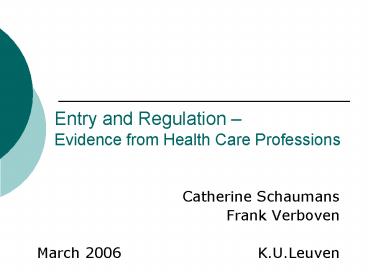Entry and Regulation Evidence from Health Care Professions - PowerPoint PPT Presentation
1 / 19
Title:
Entry and Regulation Evidence from Health Care Professions
Description:
applies to both conduct and entry. Economic debate: Public interest view (Pigou... Dummy variable, 1 for region of Flanders. Flanders. 0.03. 0.06 ... – PowerPoint PPT presentation
Number of Views:38
Avg rating:3.0/5.0
Title: Entry and Regulation Evidence from Health Care Professions
1
Entry and Regulation Evidence from Health Care
Professions
- Catherine Schaumans
- Frank Verboven
- March 2006 K.U.Leuven
2
Professional regulation
- applies to both conduct and entry.
- Economic debate
- Public interest view (Pigou)
- Private interest view (Stigler, Posner)
- Public policy
- U.S. antitrust laws apply since 1975.
- Europe only recent interest to make regulations
in line with competition policy. - See declarations by Monti in 2003.
3
Health Care Professions
- Links between both professions
4
The Establishment Act
- In every town, the number of pharmacies is
restricted based on population criteria.
5
Public interest motivation for pharmacy regulation
- The combination of
- high regulated markups
- geographic entry restrictions
- guarantees
- sufficient entry in unprofitable areas
- without generating excessive entry elsewhere.
6
Empirical questions
- What kind of strategic interaction exists
- within the professions
- between the professions?
- Can the public interest motivation of the
regulation be supported? - Deregulating entry restrictions
- Lowering regulated markups
7
Rest of presentation
- Intuition of the entry model
- Empirical results
- Competition within professions
- Interaction between professions
- Evaluation of public interest view
- Conclusions
8
General intuition of the entry model
- We want to relate profits to the number of firms.
- We do not directly observe profits, but only
- the number of entering firms
- (and regulated wholesale markups).
- To infer profits we therefore assume Nash
equilibrium - firms enter as long as this is profitable, given
other firms entry decisions. - Modify the standard entry model to account for
- markets with binding entry restrictions
- interaction between different types (pharmacies
versus physicians).
9
General intuition of the entry model
- Empirically, we observe the number of pharmacies
and physicians per town - We relate this to demographics, including
population. - Interpretation of results
- If market size needs to more than double to
support twice the number of pharmacies, this
implies that additional entry lowers profit
margins. - If predicted number of firms would be higher than
what is legally allowed, then the entry
constraints are binding.
10
- Data on 847 small Belgian towns
- Demographics (NIS, Ecodata)
- Number of firms (RIZIV)
Source NIS, Ecodata
11
Source RIZIV
12
(No Transcript)
13
(No Transcript)
14
Summary of profit effects to pharmacies
- Market profitability is positively affected by
- market size (population)
- old and unemployed.
- Additional entry by pharmacies reduces profits,
but this - is only due to reduced sales
- is not due to reduced profit margins.
- Additional entry by physicians increases profits,
hence - both professions provide complementary services.
- The entry restrictions are strongly binding, i.e.
- at regulated wholesale markups more pharmacies
want to enter.
15
Policy reforms
- What is the impact of
- reducing the fixed wholesale markups
- lowering the entry restrictions
- on
- total number of pharmacies (and physicians)
- number of markets without pharmacy?
- Answering these questions is important to
evaluate the public interest view of regulation.
16
(No Transcript)
17
(No Transcript)
18
Summary of policy reforms
- Deregulation has both direct effects on
pharmacies and indirect effects on physicians - Deregulating entry and adjusting regulated
markups such that the total number of pharmacies
remains constant, leads to - large markup reductions (tax savings)
- no loss in availability (geographic coverage).
- ?No public interest motivation for the current
regime.
19
Conclusions
- Findings
- Entry decisions of pharmacies and physicians are
strategic complements - No competition within professions
- No support for public interest view of regulation
- Further work on deregulation or re-regulation in
other professions needed.































